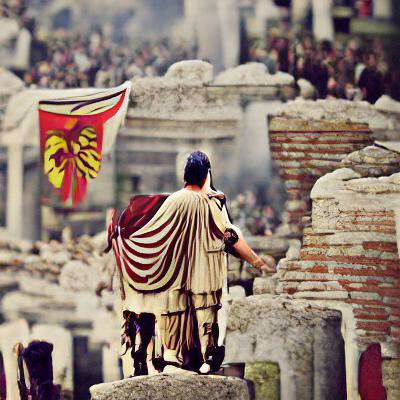
The History of Rome and the Roman Empire spans an incredibly long and varied period. From its mythical founding of Rome sometime around 739 b.c, to the fall of Constantinople and the extinguishing of the last vestiges of the Roman Empire, the history of Rome spans well over 2,000 years. If we include its later career as the principal seat of the Catholic Church and the capital of a reunified Italy, Rome;s history is even longer. Whichever span of time we choose, the history of Rome covers a large percentage of recorded history and has an outsized effect on shaping human civilization and culture.
According to legend, Rome was founded by two twins, Romulus and Remus, who had been abandoned and raised by a she-wolf. Cases of wolves and other animals actually adopting and raising animals have actually been recorded, but the Romulus and Remus story is likely false. It is also unlikely that anyone raised by an animal would have been able to acquire human language, let alone rise to a position of leadership. Historians and linguists suspect that the story of the she-wolf alludes to a more mundane origin: in Roman slang, a she-wolf meant a prostitute, and so the founders of Rome may trace their lineage to a more squalid and prosaic origin.
Rome' origins were not only humble but disreputable. At first the so-called city was little more than an armed camp of robbers, without any women or families. The outlaws fixed their lack of women in typical Roman fashion by kidnapping women from the local Sabine tribes. According to legend, the Sabine women then interceded with their relatives to prevent them from massacring the Romans in retaliation, thus paving the way for Rome's rise to greatness.
No one would have predicted that this little village would one day become the greatest city on earth, the focal point of every road and trade route, and the temporal and spiritual capital that the world had ever seen. Early Rome was penned in by Latin tribes and the Etruscan confederacy. And beyond these early foes were the mighty Celts, Carthaginians, Greeks and other people.

One by one, the Romans defeated them all, expanding first into central Italy and then beyond. Eventually, Rome ruled undisputed over all the lands of the Mediterranean (which the Romans called Mare Nostrum, Our Sea) and all of what is modern Italy, England, France, Switzerland, the Balkans, Turkey, Greece, Syria, Palestine, and Egypt. The scale of this empire has rarely been repeated. Even now, the European Union is considerably smaller than the Roman Empire at its height.
Rome met its match on the German frontier, where its dreams of expanding eastward were dashed by Germanic tribes and in the east where the Parthian empire proved to be a mighty foe. Eventually the Roman Empire settled into a static defence, holding fortified frontiers on the Rhine, Scotland, the Danube and on what is now the Iraq-Syria frontier. It fought off many incursion of enemy tribes, proving its resilience, but eventually it was overwhelmed by the mass movement of barbarians that swamped the German frontier and Muslim invaders from the Arabian peninsula that took its Egyptian and North African possessions. Even so, Rome endured. The eastern half of the empire it had established, with its capital in Constantinople, endured until 1450. It is a testament to the scope of Roman history that the Rome was founded in the bronze age, yet its empire died in a battle fought with gunpowder, just as the New World was being discovered and the Renaissance was beginning.
Such a broad subject as the History of Rome cannot be covered easily in an online article. We have provided just the briefest outline. If you ware interested in delving more deeply into the history of Rome and the Empire that it built, the links below provide access to more in-depth information.